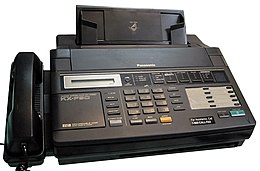
Back فاكس Arabic فاكس ARZ Faks Azerbaijani فاکس AZB Faksos BAT-SMG Факс Byelorussian Факс Bulgarian ফ্যাক্স Bengali/Bangla Pelleiler Breton Fax Catalan


Fax (short for facsimile), sometimes called telecopying or telefax (short for telefacsimile), is the telephonic transmission of scanned printed material (both text and images), normally to a telephone number connected to a printer or other output device. The original document is scanned with a fax machine (or a telecopier), which processes the contents (text or images) as a single fixed graphic image, converting it into a bitmap, and then transmitting it through the telephone system in the form of audio-frequency tones. The receiving fax machine interprets the tones and reconstructs the image, printing a paper copy.[1] Early systems used direct conversions of image darkness to audio tone in a continuous or analog manner. Since the 1980s, most machines transmit an audio-encoded digital representation of the page, using data compression to transmit areas that are all-white or all-black, more quickly.
Initially a niche product, fax machines became ubiquitous in offices in the 1980s and 1990s.[2] However, they have largely been rendered obsolete by Internet-based technologies such as email and the World Wide Web, but are still used in some medical administration and law enforcement settings.[3]
- ^ Rouse, Margaret (June 2006). "What is fax?". SearchNetworking. Retrieved 25 July 2012.
- ^ Shapiro, Carl; Varian, Hal R. (1999). Information Rules: A Strategic Guide to the Network Economy. Harvard Business Press. p. 13. ISBN 978-0-87584-863-1.
- ^ Cite error: The named reference
:0was invoked but never defined (see the help page).